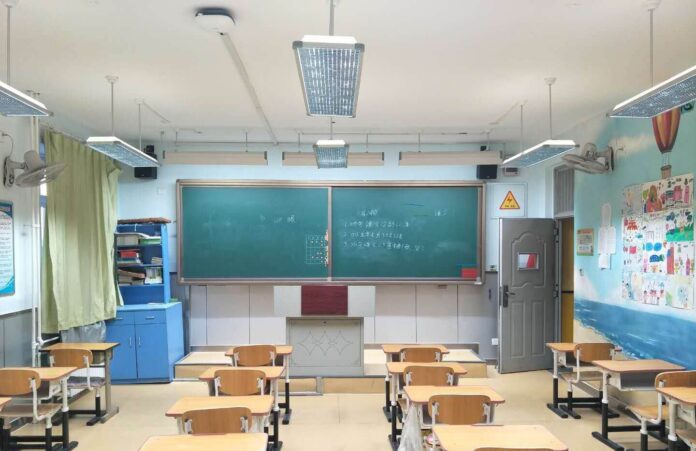
The reasonable design of classroom lighting affects students’ vision and learning, so what should we do when designing classroom lighting?
Steps
(1) Classroom desks are generally arranged in a regular arrangement facing the blackboard, and it is advisable to use the lighting method of uniform lighting on the ceiling.It should be 2.5-2.9m, and the distance from the desk should be 1.7-2.1m.
(2) Optical laboratory desks, microscope experiment desks in biological laboratories, and experimental benches in geography classrooms with simple planetariums or places requiring careful observation and recording. Local lighting should be provided.
(3) The control switch of classroom lighting should be set in sequence in the direction parallel to the outer window (the blackboard lighting switch should be installed separately). When there is a projection screen, the lighting switch near the projection screen should be able to be set independently, and some corridor lighting fixtures should be turned off during class.

(4) The lighting of the multimedia classroom should meet the requirements of vertical illuminance, and the general lighting near the screen should be able to be turned off independently, so that the screen content can be seen clearly to meet the normal visual requirements.
(5) The installation height of the lamp has a certain influence on the lighting effect. When the height of the lamp increases and the illuminance decreases, the installation height decreases, the glare increases, and the uniformity decreases. The installation height of the classroom lamps from the ground
(6) There are many lamps in the amphitheater (co-class classroom or lecture hall), and glare interference will increase. It is advisable to choose lamps with better glare limiting performance, such as lamps with grilles or diffuse reflectors (covers), and protective corners. Larger open-type lamps.

(7) Classroom lighting for painting, arts and crafts, etc. Generally, natural lighting from skylights facing north is the best lighting. Therefore, in order to display objects more realistically in painting, arts and crafts and other classrooms, high color rendering light sources should be used and indirect lighting should be used to truly express the shadows of the objects.
(8) In lecture halls, large classrooms and other places where there are TV teaching, lighting for taking notes and general lighting used in TV teaching should be set up, and general lighting should be dimmed.
(9) A special blackboard lamp should be installed in front of the blackboard in the classroom, the average value of its vertical illuminance is greater than or equal to 200lx, and the uniformity of illuminance on the blackboard surface is greater than or less than 0.7. A special blackboard lamp with asymmetric light intensity distribution characteristics should be used. The protection angle of the lamp on the side of the student seat should be greater than 40 degrees, and no direct glare should be produced.
(10) Bookstore lighting should adopt narrow light distribution or other suitable light distribution lamps. The distance between lamps and flammable objects such as books should be greater than 0.5rn. The power distribution box for the bookstore lighting should have a power indicator and be located outside the bookstore, and the bookstore channel lighting should be independently set up with switches (switches that can be controlled in two places at both ends of the channel).
(11) For the studio’s studio area, the vertical illuminance (artistic performance) should be 1000-1500lx. The electricity consumption of the studio lighting is estimated at 0.6-0.8km/m in the preliminary design. When the height of the studio is less than 7m, it is advisable to use track-type lighting, and when it is higher than 7m, a fixed lighting method can be used. Emergency lighting should be provided when the area of the studio exceeds 200㎡.

(12) Principles of lighting fixture layout. It is arranged above the passage with the long axis perpendicular to the blackboard, and the lighting effect is the best. If the luminaire has a good horizontal light distribution, it can effectively control glare, the protection angle of the luminaire is large, the brightness of the luminaire surface is not much different from the ceiling surface, and the luminaire layout can also be parallel to the blackboard.
(13) Lighting of the reading room. When there is a ceiling, dark-coated fluorescent lamps should be used, and the general lighting should be controlled along the parallel direction of the outer window or branched control. The sockets in the reading room should be set equal to or more than 15% of the number of seats in the reading room.
(14) Computer classroom lighting. Should avoid the visual impact on the display screen by high-brightness light sources such as lamps and windows, lamps with bat-wing light intensity distribution characteristics should be selected.
(15) One or more sets of power safety sockets should be set on the front and back walls of ordinary classrooms and lecture classrooms (combined lecture classrooms).
(16) The public lighting in the library and the lighting in the work (office) area should be distributed and controlled separately.
Precautions
- It is most important to pay attention to safety when selecting lamps. In addition, whether the lamps have radiation or not will cause harm to the health of students.
- The selection of lamps and lanterns should choose high color rendering index, so as to better protect the eyesight of students and reduce the incidence of myopia.
